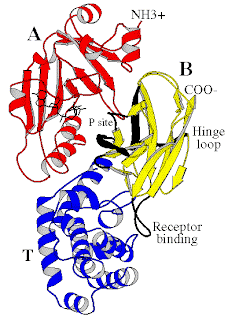Diptheria toxin is a protein secreted by Corynebacterium diphtheriae.
The protein has three domains - A, B and T. The B domain is believed to be responsible for recognizing the cell surface receptors. The toxin is found to show affinity for heparin binding epidermal like growth factor like precursors, which are found on the cell surface. T domain aids the protein to gain entry into the cell. 
The A chain has the enzymatic activity. It catalyzes the ADP ribosylation of eukaryotic aminoacyl transferase II. This prevents protein biosynthesis in the cells leading to cell death.
The diphtheria toxin A (DT - A) chain's toxic properties can be exploited by properly guiding them to the cells that need to be killed.
This is exactly what the researchers have done using nanotechnology.
A nanoparticulate system made of Poly(beta amino ester) polymer and poly( butane diol diacrylate co amino pentanol) was used to deliver the diphtheria toxin A (DT - A) gene. This gene is linked to a regulatory sequence that gets activated only in prostate cancer cells. While the specificity is taken care of by the gene regulator, safe delivery of the toxin into these cells is the responsibility of the nanoparticulate system. Now, the diphtheria toxin does the rest.
Studies in the laboratory show promising results. Well, I guess we can expect efficient nano based injectable or ingestible drugs to treat cancer in the near future.











0 comments:
Post a Comment